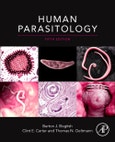Human Parasitology, Fifth Edition emphasizes a medical perspective that also incorporates functional morphology, physiology, biochemistry and immunology to enhance appreciation of the diverse implications of parasitism. Bridging the gap between classical clinical parasitology texts and traditional encyclopedic treatises, the book will not only appeal to students interested in the medical aspects of parasitology, but also those who are interested in gaining a solid foundation in the biology of parasites. This updated edition has been fully revised to integrate the most recent molecular discoveries about mosquitoes, ticks and other arthropods as vectors, along with the most effective therapeutic regimens for each.
Table of Contents
1. Symbiosis and Parasitism 2. Parasite-Host Interactions
Part I: The Protozoa 3. General Characteristics of the Euprotista (Protozoa) 4. Visceral Protozoa I: (Amoebae) and Ciliophorans 5. Visceral Protozoa II: Flagellates 6. Blood and Tissue Protozoa I: Hemoflagellates 7. Blood and Tissue Protozoa II: Human Malaria 8. Blood and Tissue Protozoa III: Other Protists
Part II: The Trematoda 9. General Characteristics of the Trematoda 10. Visceral Flukes 11. Blood Flukes
Part III: The Cestoda 12. General Characteristics of the Cestoda 13. Intestinal Tapeworms 14. Extraintestinal Tapeworms
Part IV: The Nematoda 15. General Characteristics of the Nematoda 16. Intestinal Nematodes 17. Blood and Tissue Nematodes
Part V: Arthropoda 18. Arthropods as Vectors
Appendix A. Drugs for Parasitic Infections: Partial List of Generic and Name Brands B. Current Chemotherapeutic Regiments C. Adverse Effects of Antiparasitic Drugs








